Back to page 1
The Design
The architects who designed the beautiful exterior, of course, also designed everything else at Camelback Ranch.
Those designers are with the aforementioned HKS, who are also responsible for such wonderful Minor League ballparks as the Dell Diamond in Round Rock, Dr Pepper Ballpark in Frisco and Dickey-Stephens Park in North Little Rock. These last two each won our Ballpark of the Year awards the season they opened.
  |
So what’s special about the architecture of this park? Pretty much everything — and there is a lot to take in, with all of the outer buildings ringing the playing field and the attractive upper-deck structure that is completely open underneath (above right).
As discussed in our review of the new ballpark in nearby Goodyear, the sheer size and scope of Camelback Ranch is almost a little offputting. Truly, you find yourself thinking, “Is all of this really essential just to play spring-training exhibitions?” I’m sure the Dodgers and White Sox think the answer is “yes,” as they and their fans have embraced the new springtime home.
For example, each team has a large clubhouse building just beyond the outfield concourse. The one on the right-field side is much larger, though. It belongs to the White Sox, and they elected to have their minor leaguers cohabitate with the big leaguers. The Dodgers, meanwhile, wanted a separate clubhouse for their minor league players, and it is located out among the practice fields southeast of the main ballpark. That makes their Major League locker room (below left) a good bit smaller than the one for the Sox (below right — and notice the mountain peaks in the distance). And in case you’re keeping score at home, there is a staggering total of 118,000 square feet of clubhouse space in this complex.
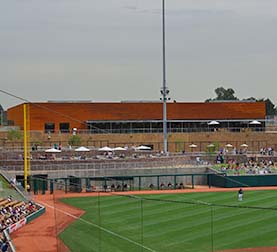  |
Another distinctive design element is the trellised overhang that extends outward from the roof of the upper level. The shot below on the left was taken from the pressbox. Not only does it show the overhang and give you a great sense of the park’s desert hues, it also shows you the vacant club seats on the upper level, which was a problem not only here but also right behind home plate.
The trellised overhang, by the way, extends from both the front and the back of the upper deck’s roof. Very attractive, indeed.
 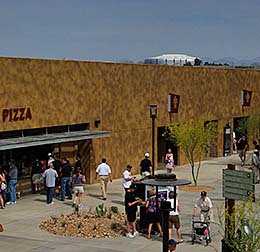 |
Speaking of the stadium’s upper level, that’s also where the photo on the right above was taken. This time, I was on the back side of the suites and pressbox, looking down at part of the plaza behind home plate. In this image, you almost see Camelback Ranch in microcosm. You see the gorgeous stonework in the walls, the impressive landscaping that’s everywhere in the park, the slanted roofline and the beautiful desert colors. You can even see the retractable-roof NFL stadium in the distance.
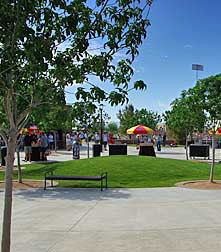 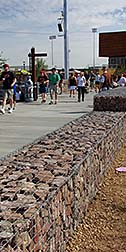 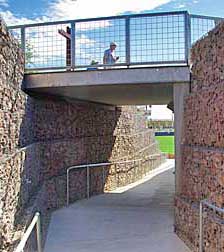 |
Another aspect of the design involves the 360-degree concourse. Like the lovely paths that meander around the lake and through the practice fields out in the complex, the concourse within the ballpark is really something to explore. It’s a long walk all the way around, but you’ll get a closer look at both of the clubhouses (and how they are absolutely sealed off from the fans inside the ballpark), the inner entry plaza in center field (above left, which includes the larger of the two walk-in souvenir stores), the berms, several group-picnic areas and numerous food kiosks.
Finally, if you’re not familiar with the term “gabion” before visiting this complex, you’ll be extremely familiar with it afterwards! Everywhere you go, you’ll find retaining — or “gabion” — walls made of small rocks wrapped in mesh fencing materials (above center and right). “The gabions are used quite often in the region for retaining,” explained HKS’ Phillips. “They are far more economical than poured concrete walls or even stone veneer on masonry walls.” So where you would expect to see cement forming the walls on the sides of tunnels or hillsides, you see rocks wrapped in metal because they, “are their own foundation and retaining all in one (plus) they flex without breaking unlike concrete which often cracks.”
Not only are they functional, they are also compatible with the rest of the scene in Camelback Ranch. “Since the use of low-maintenance landscaping is used throughout the campus, the use of the gabions was a natural fit to further enhance that natural desert appearance,” said Phillips.
And how much rock was needed to create all of the gabion walls within the complex? For months, anywhere from five to ten large trucks per day hauled in the rocks needed to create these walls.
The Essentials
At first glance, you might assume that this enormous “ranch” would offer every feature you’d ever expect to find at a baseball facility. Well, you would be right — with one glaring exception.
Before we get to the omission, let’s first look at what attending an exhibition game here at Camelback Ranch is like, and what it costs. Whether you park in the far-south lot along Camelback Road — with its very long walk to the stadium — or in the lots along the northern edge of the complex next to the park, the cost is the same: $5. But that’s just the beginning of the expenditures here — although one of the days I was there, a wonderful mariachi band provided free entertainment to fans entering through the outfield gates.
While you can spend as little as $8 for general admission to sit on the outfield berm ($10 for “premium” games), reserved seats will run you much more. In some instances, much, much more.
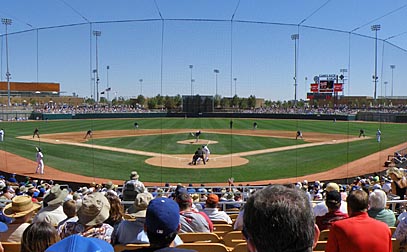 |
A high percentage of fans sit in the Infield Boxes, which cost $24 ($28 for premium games). Don’t let the word “box” fool you, though, as these rows are the ones in the back half of the seating bowl in the infield (the shot above was taken from this section). The ones just behind the aisleway that crisscrosses all of the sections are called Premium Infield, and cost $26/30. On the field side of that aisleway, though, is where the well-heeled sit. The rows right behind the dugouts are called, appropriately enough, Dugout Field Boxes and cost $30/35. The Premium Dugout seats behind the on-deck circles cost $40/45. Sections 14, 15 and 16, which are directly behind home plate, carry the pricetag of $90 for regular games and $100 (yes, $100) for premium games.
These Home Plate Club seats do include access to shaded dining areas on the concourse behind home plate, but $100? These are spring-training exhibition games, after all. Not surprisingly, these high-priced seats were moderately uninhabited the two games I attended. In fact, there were stands on the concourse to encourage ticket-holders to swap in their ducats and buy-up to the $100 seats. I saw no takers. Suite level seats behind home plate on the upper level run $75/90. Again, these sections were fairly empty when I was there.
Farther down the lines in the seating bowl, there are other options with prices that range from $18 to $30.
By the way, five of the Dodgers’ 15 home exhibitions in 2009 qualified as “premium” games, and five of the Sox’ 14 home games were premium. The “caramel” colored seats, for your information, are fairly comfortable, as they are 20″ or 22″ wide, fairly typical in newer parks these days. Oddly, though, only the most expensive seats have cupholders.
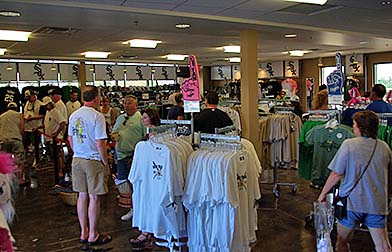 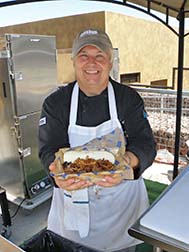 |
There are two walk-in souvenir shops, which might seem odd, but remember the enormity of this ballpark. I’m not sure the two stores are even in the same zipcode.
The one behind home plate is just inside the main entryway there. I stopped by several times during the two games I attended, and shoppers were always packed inside like sardines. The one near the center-field gates was more spacious, but I wasn’t overwhelmed by the merchandise selection. Truly, Goodyear’s single store seemed to provide greater variety. To be fair, that might be a different story in 2010 when Goodyear has to stock the wares of two franchises, like Glendale does now. The Dodger and ChiSox adult T-shirts ranged in price from $22-28, with a significant number at the low end of that range. Adjustable caps were $22. And lapel pins, my favorite collectible item, were already sold out with two weeks yet to go in spring training.
But there was no problem finding food at Camelback Ranch! In addition to the fixed points of sale behind the infield and in the entry plaza in center field, you’ll find concession kiosks every few feet all the way around the concourse. The ones that caught my eye were a stir-fry stand behind first base, Gelato (dairy-based Italian Ice) for $4 behind first base and in left field, Mexican food and $7 margaritas in the right-field corner, garlic fries for $6.50 in right field, bratwurst and Italian sausage for $6.50 in left center field … and then there’s my favorite of all. The BBQ kiosk near the left-field corner (above right, with proprietor Rodney Jankowski showing off the brisket sandwich) featured some of the best-tasting BBQ pork and brisket I’ve had outside of Texas. Both are $7.50 and are worth it.
At the fixed stands, prices for regular hot dogs are $4.50, bottles of water (an absolute must in this climate) are $3.50 and draft beer is $5.50 for domestics and $6.50 for “premium.” Note that the premium offerings vary from stand to stand, so it’s fun to go on a search to see what specialty brews await you in different parts of the park.
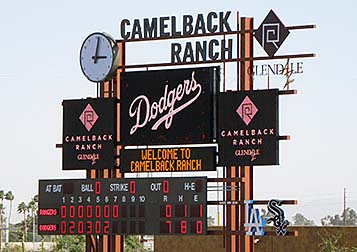 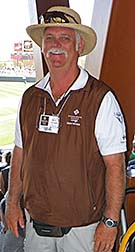 |
The scoreboard in right-center field (above) is hardly run-of-the-mill. It features three high-resolution video screens surrounding a black-and-white message area for batter info. This is all above the standard three-line game info along the bottom. It’s been a long time since I’ve seen such a novel approach to a new scoreboard, and this is one of Camelback Ranch’s numerous special elements.
Customer service (ushering, guest services, etc.) was excellent. I was anxious to see how smoothly this worked because this facility operates differently in this regard than most other Arizona parks. Elsewhere, non-profit organizations typically provide volunteers to handle these tasks, and then spend the funds raised on their charitable efforts. Here, though, the Dodgers and White Sox formed a limited partnership to hire parking attendants and ushers, and provide them with very attractive attire (above right). The process seemed to work well.
Finally, one aspect of the complex that really adds to the aesthetics is the landscaping. It is phenomenal. There are about 5,000 plants here, including a row of mature Afghan pines that act as the batter’s eye in center field. The budget for landscaping alone was a staggering $4 million, but it truly adds to the desert theme and helps make this one of the most aesthetically pleasing places in Arizona.
So what is the glaring omission in this ballpark? An area for kids. You could make the case that the large grassy areas, especially behind the batter’s eye in center field, give youngsters a place to run around and play, but that’s not the same as a playground or an area for inflatables. Because the footprint of the park is so immense, I thought maybe it existed and I just overlooked it. I made a point of going to the guest services window to ask, and they confirmed that there is indeed no playground. Perhaps there’s one planned for the future, but there’s not one now, and I think that’s a deficiency.
Summary
So Camelback Ranch lacks a playground. Believe me, though, it lacks very little else. With the largest seating capacity of any springtime ballpark, and the nicest overall complex in baseball, the place is a little overwhelming. If you want to take it all in, do what I did: go for two games, not just one. I mean, if you wanted to see all of Ben Cartwright’s Ponderosa, you wouldn’t expect to take in everything in a single afternoon.
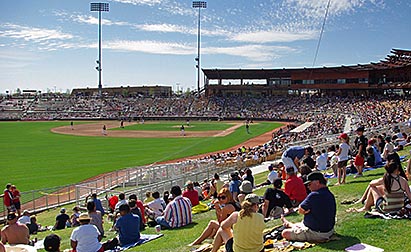 |
Technically, this land wasn’t a “ranch” prior to the arrival of baseball … but the name Camelback Ranch really fits. And while Jupiter, Surprise and Goodyear give it a run for its money, the ballpark in the midst of this project might just be the nicest where springtime baseball is played. It’s certainly the largest!